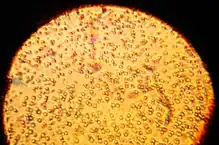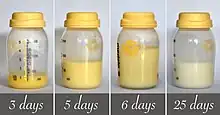Human milk immunity

Human milk immunity refers to the protection provided by mother to infant via the biologically active components in human milk. Human milk was previously thought to only provide passive immunity primarily through Secretory IgA, but advances in technology have led to the identification of various immune-modulating components.[1][2][3] Human milk constituents provide nutrition and protect the immunologically naive infant as well as regulate the infant's own immune development and growth.[4]
Immune factors and immune-modulating components in human milk include cytokines, growth factors, proteins, microbes, and human milk oligosaccharides.[5][6] Immune factors in human milk are categorized mainly as anti-inflammatory[2] primarily working without inducing inflammation or activating the complement system.[7]
Immune factors
Bio-active constituents of human milk that have been cataloged to possess immune-modulating capabilities include immunoglobulins, Lactoferrin, Lysozyme, oligosaccharides, lipids, cytokines, hormones, and growth factors.[7][8] Some of the roles of bio-actives in human milk are theorized based on their function in other parts of the body, but the mechanisms and function of their activities remain to be discovered.[9]
IgA
Immunoglobulin A is the most well known immune factor in human milk.[2] In its secretory form, SIgA, it is the most plentiful antibody in human milk.[2][8] It constitutes between 80-90% of all immunoglobulins present in milk.[8] SIgA provides adaptive immunity by directly targeting specific pathogens that both infant and mother have been exposed to in their environments.[2][10]
Lactoferrin
Lactoferrin is an immune protein with strong anti-microbial function in human milk.[11] Lactoferrin protects the infant intestine by binding to iron to prevent pathogens from utilizing it as a resource. It also modulates immunity by blocking inflammatory signaling cytokines.[7]
Cytokines
Cytokines are pluripotent signaling molecules with the ability to bind to specific receptors.[3] They can cross the intestinal barrier and mediate immune activity.[12] Their presence in human milk may stimulate lymphocytes responsible for the development of the infant's specific immunity.[7] Cytokines present in human milk include IL-1β, IL-6, IL-8, IL-10, TNFα, and IFN-γ.[3]
Origin and Establishment
Bio-active components in human milk are speculated to colonize in human milk in several ways including secretion by the mammary gland, epithelium cells, and by milk cells.[3][12] Maternal immune factors are transferred by lymphocytes traveling from the mother's gut to the mammary gland[8] where the secretory cells of the breast produce antibodies.[10]
The origin of the human milk microbiota, including those with immune-modulating functions, are not well established. However, several theories including skin-to-skin contact,[2] the entero-mammary pathway,[13] and retrograde back-flow hypothesis[14][15] have been put forth to explain the microbial composition of human milk.
Known factors of influence

Lactation stage
Human milk immune composition is known to change over the course of lactation.[12] Most notably, antibody levels are lower in mature milk than in colostrum,[7] with SIgA measuring at up to 12 grams per liter in colostrum and decreasing to 1 gram per liter in mature milk.[8] Studies find time postpartum to be most influential on the presence of immune factors, including growth factors[16] and lactoferrin.[11]
Human milk microbiome
The exposure to microbiota through mother's milk is the primary stimulus for immune development in infants.[8] Microbiota interacts with the infant's immune system by stimulating the mucous layer, down-regulating the inflammatory response, producing antibodies and helping initiate oral tolerance.[17] Mucosal layers protection comes from their ability to limit pathogens from attaching to the infant intestinal tract.[8]
Human milk oligosaccharides
Human milk oligosaccharides (HMOs) are carbohydrate components in human milk.[12] They are mostly indigestible and work as a prebiotic to feed commensal bacteria in the infant gut.[9][18] Studies show that HMOs also function as immune-modulators by blocking receptors that allow pathogenic bacteria to attach to the infant intestinal epithelium.[19]
Delivery mode
There are observed differences in immune factor composition in the milk of mothers who delivered cesarean versus vaginally.[20] A study of 82 women saw an increase in the levels of IgA in the colostrum of women who had cesarean births after experiencing labor when compared to women who delivered vaginally or had elected cesareans.[21]
Maternal Characteristics
Parity
Milk immunity levels are observably lower in women with higher parity.[22] A study among the Ariaal women of Kenya saw that milk IgA decreased drastically only in women who had given birth to eight or more children.[23]
Diet
Human milk composition remains relatively stable despite maternal dietary changes, except in cases of extreme maternal depletion. Seasonal changes and malnutrition influence the concentration of immune factors.[22]
In addition, intervention studies have confirmed that both fish oil[24] and fish consumption during pregnancy can alter immune-modulating components in human milk.[25]
Environmental factors
Differences in the maternal environment such as rural and urban environments,[26] including exposure to farming,[27] and exposure to pathogens[28] have shown to affect human milk immune factor variation.[2]
Geographic location
Geographic location is known to play a role in human milk variation, with country of residence specifically linked with immune factor variation.[29] A study found a variation in levels of growth factor in both mature milk and colostrum to be correlated with geographic location.[16] However, a larger study found support for consistency in the presence of a small group of immunological factors in mature milk independent of geographic location.[26]
Impact on health
Health outcomes for Breastfed versus formula-fed infants

Over the last century, breastfeeding has been consistently shown to reduce infant mortality and morbidity, particularly of infectious disease.[8] Comparative research between human milk and formula has pointed towards the bio-active components in human milk as potential proponents of its immunological protection.[9] Studies have shown that breastfed infants respond better to vaccines,[30] and are better protected against diarrhea, otitis media, sepsis, and necrotizing enterocolitis,[7] celiac disease, obesity, and inflammatory bowel disease than formula-fed infants.[1] Human breast milk is seen as particularly beneficial to infants born before full term and those that are underweight at birth who are at a higher risk of infectious diseases, such as sepsis and meningitis.[7][30] Also, there is a lower chance of contamination acquired through direct breastfeeding than with mixing formula with water or other animal milks which may also help explain why human milk is more protective for the infant.[31]
Long term protection
Because various components present in human breast milk stimulate the growth of the immune system, there is a growing interest in whether breastfeeding provides a long term protective effect against auto-immune and inflammatory diseases.[7]
Milk sharing and donor milk
The WHO infant feeding guidelines advise the use of donor milk when the mother's milk is not available.[32] With the understanding that breast milk provides immune protection that is absent in formula, mothers have turned to milk sharing options to in order to give formula alternatives to their infants.[33] A donation of milk without monetary benefit defines milk sharing.[32] In addition, milk banks have emerged to regulate and pasteurize donated milk to be sold in the legal market.[33] The main concern with bank milk is that it has lost many immune cells, commensal microbiota and bio-active proteins during the pasteurization process.[34] Donor milk is in high demand for infants in the Neonatal Intensive Care Unit (NICU).[33] who have been shown to benefit most from access to human milk[35]
Immunological consequences or benefits of milk sharing are not well documented, but it has been speculated that allo-nursing, or nursing from multiple females, may provide infants with an immune boost.[33] The reported risk associated with unregulated sharing milk includes the possibility of the transmission of drugs, toxins, pathogenic bacteria, HIV and other viruses.[33] However, some researchers believe that allo-nursing and milk sharing may have been part of our evolutionary past. Evidence of milk sharing history include the wet nursing practices of the 20th century,[33] milk kinship among Islamic tradition,[36] and documentation of allo-nursing in primates species.[33][37]
Non-human milk immune profiles
Mammalian milk

All mammalian milk contains water, sugar, fat, vitamins and protein with the variation within and between species and individuals differing mainly in the amount of these components.[38] Other than the variation in quantity of these components, not a lot is known about bio-active or immune-modulating factors in many mammalian species. However, in comparison to other mammalian milk, human milk has the most oligosaccharide diversity.[4]
Bovine milk
Unlike humans, ruminant mothers do not transfer immunity to their infants during pregnancy, which makes milk the first introduction to maternal immunity calves receive.[39] Bovine milk contains both immunoglobulins A and G, but in contrast to human milk where IgA is the most abundant, IgG is more abundant.[40] Secretory Component, IgM, both anti-inflammatory and inflammatory cytokines, and other proteins with antimicrobial functions are also present in bovine milk.[39]
Crop milk
Crop milk is a secretion from the crop of a bird that is regurgitated to feed their offspring.[41] Birds that produce this secretion include pigeons, flamingos, emperor penguins, and doves.[42] Pigeon milk contains some immune-modulating factors such as microbes and IgA, as well as other components with similar biological activities to mammalian milk including pigeon growth factor, and transferrin.[43]
Evolutionary implications
There is evidence of a relationship between the microbes that have co-evolved with humans as their host and the human immune system.[44] The transfer of microorganisms from mother to offspring is universal in animals. In humans, microbial exchange occurs primarily through placental transfer and breast milk.[45] The presence of these complex microbial communities in the human body suggests that the immune system has been selected to remember and mediate the colonization of these microorganisms within the human host.[46] Further, microbial dysbiosis in infants is strongly associated with immune-mediated diseases such as allergies and necrotizing enterocolitis.[17]
In early life, an infant's immune system is considered immature due to its lack of resources necessary for defense against infection.[7] An infant is not able to produce specific cytokines,[30] IgA,[7] and is limited to producing mostly IgM antibodies.[30] The human infant is unable to adequately protect itself without the immune-stimulating and immune-modulating components present in human milk. This dynamic affirms the consensus among researchers that human milk evolved to provide not only nutritional but immunological benefits to the infant.[23] Some researches have proposed that the mammary gland and milk production evolved as a part of the human innate immune system,[47] with its immunological protective role predating its nutritional role.[48]
See also
- Human milk microbiome
- Human milk oligosaccharide
References
- 1 2 Petherick A (December 2010). "Development: Mother's milk: A rich opportunity". Nature. 468 (7327): S5-7. Bibcode:2010Natur.468S...5P. doi:10.1038/468S5a. PMID 21179083.
- 1 2 3 4 5 6 7 Miller E (2018). "Beyond Passive Immunity Breastfeeding, milk and collaborative mother-infant immune systems". In Tomori C, Palmquist AE, Quinn EA (eds.). Breastfeeding New Anthropological Approaches. New York: Routledge. pp. 26–36. ISBN 978-1-138-50287-1.
- 1 2 3 4 Garofalo R (February 2010). "Cytokines in human milk". The Journal of Pediatrics. 156 (2 Suppl): S36-40. doi:10.1016/j.jpeds.2009.11.019. PMID 20105664.
- 1 2 Martin MA, Sela DA (2013). "Infant Gut Microbiota: Developmental Influences and Health Outcomes". In Clancy KB, Hinde K, Rutherford JN (eds.). Building Babies. Springer New York. pp. 233–256. doi:10.1007/978-1-4614-4060-4_11. ISBN 9781461440598.
- ↑ Collado MC, Cernada M, Baüerl C, Vento M, Pérez-Martínez G (2012-07-14). "Microbial ecology and host-microbiota interactions during early life stages". Gut Microbes. 3 (4): 352–65. doi:10.4161/gmic.21215. PMC 3463493. PMID 22743759.
- ↑ Cabrera-Rubio R, Collado MC, Laitinen K, Salminen S, Isolauri E, Mira A (September 2012). "The human milk microbiome changes over lactation and is shaped by maternal weight and mode of delivery". The American Journal of Clinical Nutrition. 96 (3): 544–51. doi:10.3945/ajcn.112.037382. PMID 22836031.
- 1 2 3 4 5 6 7 8 9 10 Palmeira P, Carneiro-Sampaio M (September 2016). "Immunology of breast milk". Revista da Associação Médica Brasileira. 62 (6): 584–593. doi:10.1590/1806-9282.62.06.584. PMID 27849237.
- 1 2 3 4 5 6 7 8 Hanson, M.D., Ph.D, Lars A. (2004). Immunology of Human Milk: How Breastfeeding Protects Babies. Amarillo, Texas: Pharmasoft Publishing. p. 22. ISBN 978-0972958301.
{{cite book}}: CS1 maint: multiple names: authors list (link) - 1 2 3 Newburg DS (2001). Bioactive components of human milk: evolution, efficiency, and protection. Advances in Experimental Medicine and Biology. Vol. 501. Springer US. pp. 3–10. doi:10.1007/978-1-4615-1371-1_1. ISBN 9781461513711. PMID 11787694.
- 1 2 Weaver LT, Arthur HM, Bunn JE, Thomas JE (March 1998). "Human milk IgA concentrations during the first year of lactation". Archives of Disease in Childhood. 78 (3): 235–9. doi:10.1136/adc.78.3.235. PMC 1717486. PMID 9613353.
- 1 2 Rai D, Adelman AS, Zhuang W, Rai GP, Boettcher J, Lönnerdal B (2014-12-02). "Longitudinal changes in lactoferrin concentrations in human milk: a global systematic review". Critical Reviews in Food Science and Nutrition. 54 (12): 1539–47. doi:10.1080/10408398.2011.642422. PMID 24580556.
- 1 2 3 4 Ballard O, Morrow AL (February 2013). "Human milk composition: nutrients and bioactive factors". Pediatric Clinics of North America. 60 (1): 49–74. doi:10.1016/j.pcl.2012.10.002. PMC 3586783. PMID 23178060.
- ↑ Rodríguez JM (November 2014). "The origin of human milk bacteria: is there a bacterial entero-mammary pathway during late pregnancy and lactation?". Advances in Nutrition. 5 (6): 779–84. doi:10.3945/an.114.007229. PMC 4224214. PMID 25398740.
- ↑ Ramsay DT, Kent JC, Owens RA, Hartmann PE (February 2004). "Ultrasound imaging of milk ejection in the breast of lactating women". Pediatrics. 113 (2): 361–7. doi:10.1542/peds.113.2.361. PMID 14754950.
- ↑ Moossavi S, Sepehri S, Robertson B, Bode L, Goruk S, Field CJ, Lix LM, de Souza RJ, Becker AB, Mandhane PJ, Turvey SE, Subbarao P, Moraes TJ, Lefebvre DL, Sears MR, Khafipour E, Azad MB (February 2019). "Composition and Variation of the Human Milk Microbiota Are Influenced by Maternal and Early-Life Factors". Cell Host & Microbe. 25 (2): 324–335.e4. doi:10.1016/j.chom.2019.01.011. PMID 30763539.
- 1 2 Munblit D, Treneva M, Peroni DG, Colicino S, Chow L, Dissanayeke S, Abrol P, Sheth S, Pampura A, Boner AL, Geddes DT, Boyle RJ, Warner JO (November 2016). "Colostrum and Mature Human Milk of Women from London, Moscow, and Verona: Determinants of Immune Composition". Nutrients. 8 (11): 695. doi:10.3390/nu8110695. PMC 5133082. PMID 27827874.
- 1 2 Houghteling PD, Walker WA (2015). "From Birth to "Immunohealth," Allergies and Enterocolitis". Journal of Clinical Gastroenterology. 49 Suppl 1 (1): S7–S12. doi:10.1097/MCG.0000000000000355. PMC 4602161. PMID 26447970.
- ↑ Davis EC, Wang M, Donovan SM (March 2017). "The role of early life nutrition in the establishment of gastrointestinal microbial composition and function". Gut Microbes. 8 (2): 143–171. doi:10.1080/19490976.2016.1278104. PMC 5390825. PMID 28068209.
- ↑ Laucirica DR, Triantis V, Schoemaker R, Estes MK, Ramani S (September 2017). "Milk Oligosaccharides Inhibit Human Rotavirus Infectivity in MA104 Cells". The Journal of Nutrition. 147 (9): 1709–1714. doi:10.3945/jn.116.246090. PMC 5572490. PMID 28637685.
- ↑ Urbaniak C, Angelini M, Gloor GB, Reid G (January 2016). "Human milk microbiota profiles in relation to birthing method, gestation and infant gender". Microbiome. 4 (1): 1. doi:10.1186/s40168-015-0145-y. PMC 4702315. PMID 26739322.
- ↑ Striker GA, Casanova LD, Nagao AT (March 2004). "[Influence of type of delivery on A, G and M immunoglobulin concentration in maternal colostrum]". Jornal de Pediatria. 80 (2): 123–8. doi:10.2223/1151. PMID 15079182.
- 1 2 Prentice AM, Roberts SB, Prentice A, Paul AA, Watkinson M, Watkinson AA, Whitehead RG (January 1983). "Dietary supplementation of lactating Gambian women. I. Effect on breast-milk volume and quality". Human Nutrition: Clinical Nutrition. 37 (1): 53–64. PMID 6341320.
- 1 2 Miller EM, McConnell DS (January 2015). "Milk immunity and reproductive status among Ariaal women of northern Kenya". Annals of Human Biology. 42 (1): 76–83. doi:10.3109/03014460.2014.941398. PMID 25154290.
- ↑ Dunstan JA, Roper J, Mitoulas L, Hartmann PE, Simmer K, Prescott SL (August 2004). "The effect of supplementation with fish oil during pregnancy on breast milk immunoglobulin A, soluble CD14, cytokine levels and fatty acid composition". Clinical and Experimental Allergy. 34 (8): 1237–42. doi:10.1111/j.1365-2222.2004.02028.x. PMID 15298564.
- ↑ Urwin HJ, Miles EA, Noakes PS, Kremmyda LS, Vlachava M, Diaper ND, Pérez-Cano FJ, Godfrey KM, Calder PC, Yaqoob P (August 2012). "Salmon consumption during pregnancy alters fatty acid composition and secretory IgA concentration in human breast milk". The Journal of Nutrition. 142 (8): 1603–10. doi:10.3945/jn.112.160804. PMID 22739373.
- 1 2 Ruiz L, Espinosa-Martos I, García-Carral C, Manzano S, McGuire MK, Meehan CL, McGuire MA, Williams JE, Foster J, Sellen DW, Kamau-Mbuthia EW, Kamundia EW, Mbugua S, Moore SE, Kvist LJ, Otoo GE, Lackey KA, Flores K, Pareja RG, Bode L, Rodríguez JM (2017). "What's Normal? Immune Profiling of Human Milk from Healthy Women Living in Different Geographical and Socioeconomic Settings". Frontiers in Immunology. 8: 696. doi:10.3389/fimmu.2017.00696. PMC 5492702. PMID 28713365.
- ↑ Peroni DG, Pescollderungg L, Piacentini GL, Rigotti E, Maselli M, Watschinger K, Piazza M, Pigozzi R, Boner AL (September 2010). "Immune regulatory cytokines in the milk of lactating women from farming and urban environments". Pediatric Allergy and Immunology. 21 (6): 977–82. doi:10.1111/j.1399-3038.2010.00995.x. PMID 20718928.
- ↑ Tomicić S, Johansson G, Voor T, Björkstén B, Böttcher MF, Jenmalm MC (October 2010). "Breast milk cytokine and IgA composition differ in Estonian and Swedish mothers-relationship to microbial pressure and infant allergy". Pediatric Research. 68 (4): 330–4. doi:10.1203/00006450-201011001-00646. PMID 20581738.
- ↑ Amoudruz P, Holmlund U, Schollin J, Sverremark-Ekström E, Montgomery SM (February 2009). "Maternal country of birth and previous pregnancies are associated with breast milk characteristics". Pediatric Allergy and Immunology. 20 (1): 19–29. doi:10.1111/j.1399-3038.2008.00754.x. PMID 18484963.
- 1 2 3 4 Hanson LÅ, Korotkova M (August 2002). "The role of breastfeeding in prevention of neonatal infection". Seminars in Neonatology. 7 (4): 275–281. doi:10.1053/siny.2002.0124.
- ↑ Bernt K, Walker WA (2001). "Human milk and the response of intestinal epithelium to infection". Advances in Experimental Medicine and Biology. 501: 11–30. doi:10.1007/978-1-4615-1371-1_2. ISBN 978-1-4613-5521-2. PMID 11787672.
- 1 2 Palmquist AE, Doehler K (April 2016). "Human milk sharing practices in the U.S". Maternal & Child Nutrition. 12 (2): 278–90. doi:10.1111/mcn.12221. PMC 5063162. PMID 26607304.
- 1 2 3 4 5 6 7 "Human Milk Sharing: Evolutionary Insights and Modern Risks". International Milk Genomics Consortium. Retrieved 2019-05-01.
- ↑ Martin CR, Ling PR, Blackburn GL (May 2016). "Review of Infant Feeding: Key Features of Breast Milk and Infant Formula". Nutrients. 8 (5): 279. doi:10.3390/nu8050279. PMC 4882692. PMID 27187450.
- ↑ Schanler RJ, Lau C, Hurst NM, Smith EO (August 2005). "Randomized trial of donor human milk versus preterm formula as substitutes for mothers' own milk in the feeding of extremely premature infants". Pediatrics. 116 (2): 400–6. doi:10.1542/peds.2004-1974. PMID 16061595.
- ↑ Thorley, Virginia (2012). "Mothers' experiences of sharing breastfeeding or breastmilk, part 2: the early 21st century". Nursing Reports. 2 (1): e2. doi:10.4081/nursrep.2012.e2. ISSN 2039-4403.
- ↑ "Why do these monkeys nurse each other's babies?". Animals. 2019-02-22. Retrieved 2019-05-01.
- ↑ Power ML, Schulkin J (2016). The Biology of Lactation Milk. Baltimore Maryland 21218-4363: Johns Hopkins University Press. p. 4. ISBN 978-1-4214-2043-1.
{{cite book}}: CS1 maint: location (link) - 1 2 Stelwagen K, Carpenter E, Haigh B, Hodgkinson A, Wheeler TT (April 2009). "Immune components of bovine colostrum and milk". Journal of Animal Science. 87 (13 Suppl): 3–9. doi:10.2527/jas.2008-1377. PMID 18952725.
- ↑ Cakebread JA, Humphrey R, Hodgkinson AJ (August 2015). "Immunoglobulin A in Bovine Milk: A Potential Functional Food?". Journal of Agricultural and Food Chemistry. 63 (33): 7311–6. doi:10.1021/acs.jafc.5b01836. PMID 26165692.
- ↑ Eraud C, Dorie A, Jacquet A, Faivre B (2008). "The crop milk: a potential new route for carotenoid-mediated parental effects". Journal of Avian Biology. 39 (2): 247–251. doi:10.1111/j.0908-8857.2008.04053.x. ISSN 1600-048X.
- ↑ Power ML, Schulkin J (2016). "Feeding Offspring". The Biology of Lactation Milk. Baltimore, Maryland 21218-4363: Johns Hopkins University Press. pp. 26–27. ISBN 978-1-4214-2042-4.
{{cite book}}: CS1 maint: location (link) - ↑ Gillespie MJ, Stanley D, Chen H, Donald JA, Nicholas KR, Moore RJ, Crowley TM (2012-10-26). "Functional similarities between pigeon 'milk' and mammalian milk: induction of immune gene expression and modification of the microbiota". PLOS ONE. 7 (10): e48363. Bibcode:2012PLoSO...748363G. doi:10.1371/journal.pone.0048363. PMC 3482181. PMID 23110233.
- ↑ Hooper LV, Littman DR, Macpherson AJ (June 2012). "Interactions between the microbiota and the immune system". Science. 336 (6086): 1268–73. Bibcode:2012Sci...336.1268H. doi:10.1126/science.1223490. PMC 4420145. PMID 22674334.
- ↑ Funkhouser LJ, Bordenstein SR (2013-08-20). "Mom knows best: the universality of maternal microbial transmission". PLoS Biology. 11 (8): e1001631. doi:10.1371/journal.pbio.1001631. PMC 3747981. PMID 23976878.
- ↑ McFall-Ngai M (January 2007). "Adaptive immunity: care for the community". Nature. 445 (7124): 153. Bibcode:2007Natur.445..153M. doi:10.1038/445153a. PMID 17215830.
- ↑ Vorbach C, Capecchi MR, Penninger JM (June 2006). "Evolution of the mammary gland from the innate immune system?". BioEssays. 28 (6): 606–16. doi:10.1002/bies.20423. PMID 16700061.
- ↑ Blackburn DG, Hayssen V, Murphy CJ (1989). "The origins of lactation and the evolution of milk: a review with new hypotheses". Mammal Review. 19 (1): 1–26. doi:10.1111/j.1365-2907.1989.tb00398.x. ISSN 1365-2907.